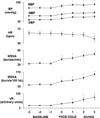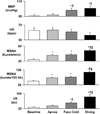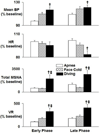Sympathetic nerve activity and simulated diving in healthy humans
- PMID: 24368150
- PMCID: PMC4249686
- DOI: 10.1016/j.autneu.2013.12.001
Sympathetic nerve activity and simulated diving in healthy humans
Abstract
The goal of our study was to develop a simple and practical method for simulating diving in humans using facial cold exposure and apnea stimuli to measure neural and circulatory responses during the stimulated diving reflex. We hypothesized that responses to simultaneous facial cold exposure and apnea (simulated diving) would be synergistic, exceeding the sum of responses to individual stimuli. We studied 56 volunteers (24 female and 32 male), average age of 39 years. All subjects were healthy, free of cardiovascular and other diseases, and on no medications. Although muscle sympathetic nerve activity (MSNA), blood pressure, and vascular resistance increased markedly during both early and late phases of simulated diving, significant reductions in heart rate were observed only during the late phase. Total MSNA during simulated diving was greater than combined MSNA responses to the individual stimuli. We found that simulated diving is a powerful stimulus to sympathetic nerve traffic with significant bradycardia evident in the late phase of diving and eliciting synergistic sympathetic and parasympathetic responses. Our data provide insight into autonomic triggers that could help explain catastrophic cardiovascular events that may occur during asphyxia or swimming, such as in patients with obstructive sleep apnea or congenital long QT syndrome.
Keywords: Arrhythmias; Bradycardia; Diving; Long QT syndrome; Microneurography; Sympathetic nervous system.
Copyright © 2013 Elsevier B.V. All rights reserved.
Figures




References
-
- Ackerman MJ, Tester DJ, Porter CJ. Swimming, a gene-specific arrhythmogenic trigger for inherited long QT syndrome. Mayo Clinic Proceedings. 1999;74:1088–1094. - PubMed
-
- Andersen HT. Physiological adaptations in diving vertebrates. Physiol Rev. 1966;46:212–243. - PubMed
-
- Anderson HT. Factors determining the circulatory adjustments to diving: I. Water immersion. Acta Physiologica Scandinavica. 1963;58:173–185. - PubMed
-
- Andersson JP, Liner MH, Fredsted A, Schagatay EK. Cardiovascular and respiratory responses to apneas with and without face immersion in exercising humans. J Appl Physiol. 2004;96:1005–1010. - PubMed
-
- Asmussen E, Kristiansson NG. The "diving bradycardia" in exercising man. Acta Physiol Scand. 1968;73:527–535. - PubMed
Publication types
MeSH terms
Grants and funding
LinkOut - more resources
Full Text Sources
Other Literature Sources

